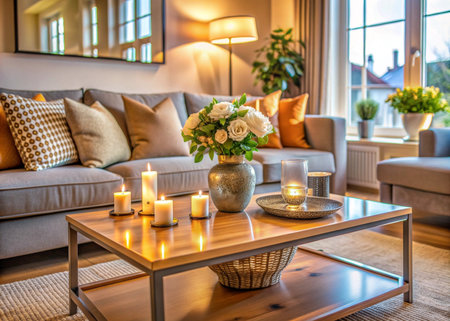Introduction: Shedding Light on British Craftsmanship
In the heart of Britain’s architectural heritage lies a captivating narrative of artistry and innovation, where traditional period lighting is not merely a functional necessity but an emblem of cultural identity. The resurgence of these classic luminaires owes much to British artisans—skilled craftspeople whose dedication to time-honoured techniques has revived the character and charm of bygone eras. Today, as contemporary living spaces seek a harmonious balance between modernity and heritage, the influence of these artisans shines brighter than ever. Their meticulous approach bridges the gap between past and present, infusing homes and public spaces with warmth, authenticity, and an unmistakable sense of place. This exploration delves into the enduring legacy of British craftsmanship in period lighting, celebrating the makers who illuminate our surroundings while preserving the spirit of tradition for future generations.
Heritage Techniques: The Heart of British Lighting
The revival of traditional period lighting in the UK owes much to the enduring mastery of British artisans, whose commitment to heritage techniques sets their work apart. These makers are guardians of centuries-old crafts, ensuring that each piece of lighting not only illuminates a space but also tells a story steeped in history. By preserving methods such as lost-wax casting, glassblowing, and meticulous hand-finishing, they bring a level of authenticity and elegance that mass-produced alternatives simply cannot replicate.
Time-Honoured Methods Still in Use
| Technique | Description | Significance |
|---|---|---|
| Lost-Wax Casting | An ancient process where molten metal is poured into a mould formed around a wax model. The wax melts away, leaving the intricate design in metal. | Enables exquisite detail and unique character in brass or bronze lamp bases and fittings. |
| Glassblowing | Molten glass is shaped by blowing air through a tube, often finished by hand for bespoke shapes and textures. | Allows for the creation of delicate shades and globes with subtle variations, enhancing period authenticity. |
| Hand-Finishing | Artisans apply patinas, polishes, or paints by hand to achieve aged effects or highlight fine details. | Imbues each item with an individual touch and depth impossible to achieve by machine. |
The Resonance of Authentic Craftsmanship
The preservation of these skills means that every fixture—be it a Georgian lantern or a Victorian chandelier—resonates with timeless elegance. Unlike contemporary reproductions, authentic period lighting crafted using heritage techniques possesses an undeniable warmth and character. This is especially valued in British homes, where respect for history and craftsmanship remains integral to interior design ethos.
![]()
3. Materials and Motifs: Local Inspirations Reimagined
British artisans have long distinguished themselves by their discerning choice of materials, drawing from a palette deeply rooted in the nation’s architectural heritage. Brass, with its warm patina, remains a staple in traditional period lighting—a nod to its prevalence in grand Georgian townhouses and Victorian parlours. Copper, prized for its subtle glow and durability, is often hand-finished to evoke an understated yet unmistakably British elegance. Opal glass, too, features prominently; its softly diffused light recalls the gas-lit ambience of Edwardian drawing rooms while bringing a contemporary clarity to classic forms.
The motifs that define British period lighting are equally evocative. Craftspeople frequently reimagine elements such as acanthus leaves, rosettes, and fluted columns—ornamental details borrowed from Georgian and Regency eras—infusing them with modern sensibility without forsaking authenticity. Victorian influences appear in intricate fretwork and etched glass shades, while Edwardian inspirations introduce lighter lines and more delicate proportions. Each piece becomes a celebration of local artistry: wrought iron twisted into graceful curves by blacksmiths in the Cotswolds, or cut crystal painstakingly assembled in Stoke-on-Trent workshops.
This revival is not mere reproduction; rather, it is an evolution. By blending time-honoured techniques with innovative design perspectives, today’s British makers pay homage to their cultural lineage while ensuring period lighting remains relevant in both heritage homes and contemporary interiors. The result is lighting that resonates with a distinct sense of place—timelessly elegant, inherently British, and infused with stories of craftsmanship passed down through generations.
4. Crafting for Contemporary Spaces
Within the evolving landscape of British interior design, the integration of traditional period lighting into modern homes has become a testament to both skilled craftsmanship and sophisticated taste. British artisans have mastered the delicate art of blending heritage fixtures with the demands of contemporary living, ensuring that each piece not only serves as a visual focal point but also meets present-day standards for functionality and sustainability.
The challenge lies in preserving the authentic character of period lighting—be it Regency chandeliers, Victorian sconces, or Edwardian lanterns—while discreetly incorporating modern technology. This thoughtful approach means that lighting is no longer just about illumination; it becomes an architectural detail that bridges eras, infusing spaces with narrative and nostalgia without sacrificing comfort or efficiency.
Aesthetic Authenticity vs. Modern Functionality
| Aspect | Traditional Period Lighting | Modern Adaptations |
|---|---|---|
| Material | Brass, bronze, cut glass, porcelain | Reclaimed metals, energy-efficient LED-compatible fittings, hand-blown glass |
| Design Detailing | Hand-engraved motifs, ornate arms, patinated finishes | Slimmed-down silhouettes, modular elements for adaptability |
| Light Source | Candle bulbs or original gaslight adaptations | Dimmable LEDs, smart bulbs compatible with home automation |
| Energy Efficiency | Low by today’s standards | A-rated components, integrated sensors and timers |
| Installation Context | Period properties with high ceilings and formal layouts | Open-plan flats, urban lofts, new builds with flexible zones |
The Role of Artisans in Contemporary Integration
British artisans are key to this evolution. Their expertise enables bespoke adaptation—retrofitting antique finds with hidden wiring or custom-crafting period-style pendants that honour original proportions while embracing innovations like low-energy bulbs or wireless controls. Collaborations between designers and craftspeople ensure that every fixture feels at home within Britain’s unique architectural vernacular, whether illuminating a Georgian townhouse or a minimalist London apartment.
Sustainability as a Design Principle
The renewed interest in traditional lighting is further enhanced by eco-conscious values. Many workshops focus on upcycling antique components and sourcing sustainable materials locally, aligning historic aesthetics with the UK’s commitment to reducing its carbon footprint. The result is lighting that not only glows with heritage charm but also speaks to the forward-thinking ethos of modern British households.
5. Championing British Artisans: Branding, Collaboration, and Community
Within the resplendent world of traditional period lighting, British artisans are not only crafting beautiful fixtures but also forging vital connections across the creative industries. These makers have become champions of local craftsmanship by actively collaborating with interior designers, architects, and heritage projects. Such partnerships go beyond mere aesthetics—they celebrate the unique character of Britain’s built environment and reinforce a sense of place that is both distinctive and deeply rooted.
Collaboration with Designers and Architects
British lighting makers frequently work hand-in-hand with renowned interior designers and architectural studios, infusing residential, commercial, and historic spaces with bespoke lighting solutions. This synergy ensures that each period-inspired fixture complements its setting—whether it’s a grand Georgian townhouse in Bath or a revitalised Victorian terrace in London. By tailoring their creations to suit specific projects, artisans preserve authentic details while accommodating contemporary needs, thereby upholding the integrity of Britain’s architectural heritage.
Heritage Projects and Local Identity
The involvement of local artisans in heritage restoration projects is particularly significant. When restoring stately homes, listed buildings, or cultural landmarks, project leaders often seek out specialist lighting makers who possess an intimate understanding of historical styles and regional materials. Their expertise guarantees historically sympathetic results while supporting traditional British trades. These collaborations not only rejuvenate treasured sites but also invigorate communities by spotlighting skills passed down through generations.
Branding and Community Engagement
Successful British lighting brands distinguish themselves through authenticity and transparency. They openly share stories about their craftspeople—their techniques, inspirations, and connection to local history—allowing customers to appreciate the human touch behind each creation. Many brands host workshops, exhibitions, or open studios that invite the public to witness artistry firsthand, fostering a vibrant sense of community around British design. By prioritising collaboration and celebrating their roots, these artisans help preserve Britain’s design legacy for future generations.
6. Sustaining Tradition: The Future of British Period Lighting
The ongoing revival of traditional period lighting in Britain is not merely a fleeting design trend—it is a testament to the enduring value of artisanal craftsmanship and its vital role in shaping our built environment. As we look to the future, the sustainability of this revival rests upon our collective commitment to supporting skilled artisans and preserving their time-honoured techniques.
Championing Artisanal Skills for Generations to Come
British artisans are at the heart of this renaissance, meticulously crafting lighting that honours historical accuracy while adapting to contemporary needs. Their expertise, often passed down through generations or honed over years of dedicated practice, forms an irreplaceable link between past and present. By fostering apprenticeships and investing in local workshops, we ensure these skills remain vibrant and accessible to new generations of makers.
Balancing Heritage and Modernity
Period lighting is more than a stylistic preference; it is an expression of cultural identity, reflecting the stories embedded within Britain’s architectural heritage. Supporting traditional craftspeople helps maintain this delicate balance—allowing homes, public spaces, and historic sites to retain their unique character without compromising on safety or efficiency. Embracing locally sourced materials and sustainable production methods further reinforces this commitment to both heritage and environmental stewardship.
A Collective Responsibility
Ultimately, sustaining the future of British period lighting requires engagement from designers, homeowners, policymakers, and communities alike. By choosing authentic, artisan-made fixtures and advocating for policies that protect traditional trades, we participate in a broader movement to safeguard our cultural legacy. In doing so, we illuminate not only our interiors but also the path forward—ensuring that the artistry and narrative richness of British lighting design continue to inspire for generations yet to come.


